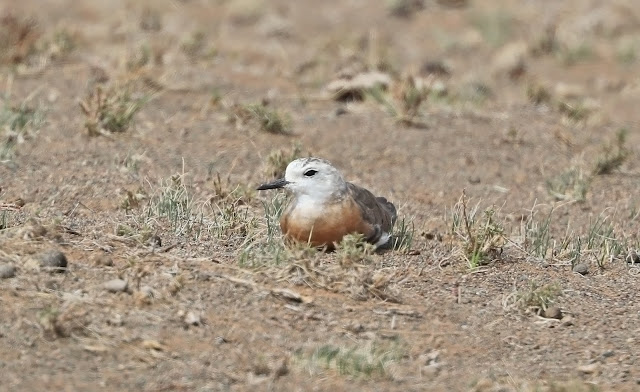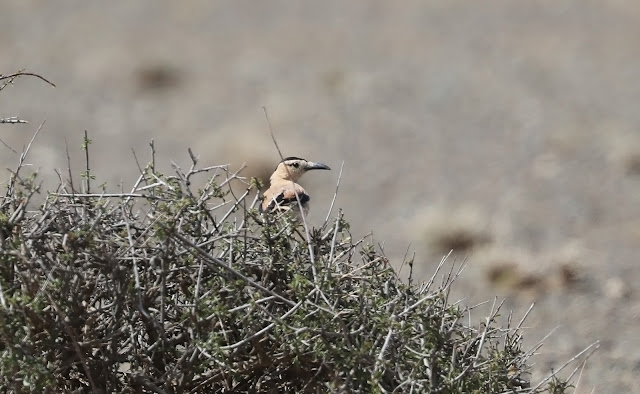On our way to a new Snow Leopard site we covered many square miles of seeming empty desert searching for Oriental Plovers.
2 Greater Sandplovers got us excited from a distance, though very nice not our main quarry.
Oriental Plover
After several hours scouring the desert Alan spotted a mixed flock of Oriental Plovers, Greater and Lesser Sandplovers. To my shame I spent all my time with Oriental Plovers thinking we would see more Sandplovers which was not the case.
Oriental Plover
Juvenile Oriental Plover
Oriental Plover
Oriental Plover
Oriental Plover
Oriental Plover
Dave & Gill nearly at the top
Our back up crew made the climb look so easy, they said it was only a 70mt climb, I struggled to the top with aid of several stops and there was no way I was going to do it again.
From the top, Mongolian 70mts
Building one of the 2 hides over looking the drinking pool which we were going to spend the night!
View from hide to the drinking pool where the horse is!
Fast approaching dust/sand storm!
When the hides were complete, we tried to make ourselves comfortable in them. They were to small for me put my legs out, sharp rocks were digging in our backs and other places, causing us to constantly fidget trying to get comfortable. As dusk began to fall a dust storm appeared several mile away but steadily came towards us. As the dust storm hit us it turned to rain and gales which was somewhat scary being stuck in the open on the top of a mountain. Our back up crew managed to erect some tents for us to spend the night in about 20mts below the summit, getting absolutely drenched for there trouble, they were marvels. I managed to fall over struggling down to the tents with camera gear and optics but only dented my pride. Even in the tents it was a long night laying on sharp rocks which ever way way you laid. At first light the storm had passed and we moved back to the hides for a few hours, unfortunately there was no sign of a Snow Leopard at the pool, but Ibex came in, asa well as Chough, Ravens, Rock Thrush, Hill Pigeons, Black Redstarts, Pied Wheatears, Crag Martins and Beautiful Rosefinches.
We made our back to the valley floor for breakfast and to discuss our next move. No amount of persuasion would get me to climb that mountain again and I wasn't alone in feeling that way. Our crew did some scouting and found a much lower vantage point from another mountain that was much easier for us to reach.
The 2 hides as viewed from near the drinking pool the day after the storm
Godlewski's Bunting
While our brilliant back up crew built 2 more hides and put out camera traps we kept out of the way, trying to get good views of elusive Godlewski's Bunting. Pied Wheatears were all around but mainly camera shy, Lammergeirer and Griffon Vultures sailed over.
Juvenile Eastern Black redstart
Pied Wheatear
Ibex from the new hides
Ibex from the new hides
Ibex from the new hides
In the afternoon the crew drove us up in the Land Cruisers over a rock strewn valley across wadi's to a new camp near the new hides, if the cars had been mine I'd have made everyone walk.
It has to be said the new hides were still far from luxurious and definitely not comfortable, once again far to small for me stretch my legs. As darkness fell I made the decision that I was going to go back to the tent to sleep, only Alan decided to remain in the hide all night with the guides. At 04.30 the next morning we went back to the hides for another 5 hours but no sign of the Leopard, though we had superb views of Ibex, also a flock of 13 Hill Pigeons came in to drink.
When the camera traps were retrieved they show no sign of any Leopards, it was my belief that the heavy rain the night before had left plenty of rock pools for them drink from. We offered the opportunity to spend another night on the mountain but we politely declined.
These 2 Ibex were on the summit but something spooked them, probably the Leopard we were looking for, it took them just a few seconds to descend several hundred feet to the valley floor and up the other side, how they did it without injuring themselves I don't know.
Lammergeirer
Leaving probably our best chance of seeing Snow Leopard we moved back into the desert around the Khongor Dune system where we stayed overnight in a very comfortable tourist camp
Juvenile Desert Wheatear on the roof of my Ger early morning
An early morning stroll around the camp saw several Pallas's Sandgrouse fly over, a couple of Lesser Kestrels, some Desert Wheatears and the ever present Tree Sparrows.
Saxaul Sparrow
When we left the tourist camp for base camp, our first stop was for Saxaul Sparrows, several pairs of these gorgeous Sparrows were nesting in some old derelict walls. While there a Booted Eagle flew over, as did some more Pallas's Sandgrouse and Upland Buzzards.
Saxaul Sparrow
Saxaul Sparrow
Saxaul Sparrow
 1
1
1 of the Desert Warblers seen showed well enough for a few images to be taken
Although our base camp was only a c100KM away it took all day to get there with numerous stops for birds, rodents and a Wild Ass
Mongolian Ground Jay
Mongolian Ground Jay was one of my target species, although several were seen in the Gobi all of them were camera shy.
Steppe Grey Shrike
Mongolian Wild Ass
Daurian Ground Squirrel?
Toad Head Lizard sp.
Pallas's Sandgrouse
Juvenile Black Vulture on it's nest











































































